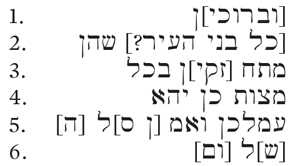Samson in the Synagogue
Please join the BAS Library or become an All Access member of BAS to gain full access to this article and so much more.
Already a library member? Log in here.
Institution user? Log in with your IP address or Username
Footnotes
See Joey Corbett, “New Synagogue Excavations in Israel and Beyond,” BAR 37:04.
See “Philistine Temple Discovered Within Tel Aviv City Limits,” BAR 01:02.
Endnotes
The Huqoq Excavation Project is sponsored by the following consortium members: the University of North Carolina at Chapel Hill; Brigham Young University; Trinity University (TX); the University of Oklahoma (2012 on); the University of Toronto (Canada); the University of Wyoming (as of 08/2012); Wofford College (in 2011). The 2011–2012 staff members were: Jodi Magness (director); Shua Kisilevitz (assistant co-director); Miki Golan (dig administrator); Chad Spigel (area supervisor of the ancient village); Matthew Grey (area supervisor of the synagogue); Tawfiq De‘adle (consultant on the modern village); Brian Coussens (assistant area supervisor of the modern village); Byron McCane (senior area supervisor in 2011); James Bucko (surveyor); Karen Britt (mosaics specialist); Jim Haberman (photographer); Mary Robinson-Mohr (registrar); Daniel Schindler (ceramics specialist); Xuân Mai Vö (faunal specialist in 2011); Haskel Greenfield and Christopher Neufeldt (faunal specialists in 2012); Carrie Swan (glass specialist); Jessie George (paleobotanical specialist); Nathan Elkins (numismatist); Paul Flesher (computer specialist); Randy Mohr (dig artist); Dov Porotsky and Slava Pirsky (preparation of top plans and section drawings); Yeshahayhu Ben-Yaacov (site conservator in 2011); Orna Cohen (site conservator in 2012); Nina Livesey (educational director in 2012); Mimi Lavie (cleaning and conservation of artifacts); and Ronni Gat (ceramics restoration). We gratefully acknowledge the financial support of various individuals and organizations, including the Carolina Center for Jewish Studies; Sheila Bishop and the Foundation for Biblical Archaeology; Judea Reform Congregation of Durham, NC; Temple Beth El of Boca Raton, FL; Mae Chesser; Elizabeth Murphy; and Robert Susick. Our discoveries would not have been possible without the hard work and dedication of the student volunteers from the consortium institutions and other universities who joined us in 2011 and 2012.
For a report on the first season, see Jodi Magness, “Huqoq–2011,” Excavations and Surveys in Israel (Hadashot Arkheologiyot) 124 (2011), posted at http://www.hadashot-esi.org.il/report_detail_eng.asp?id=1959&mag_id=119.
David Amit reconstructs the inscription in Hebrew as follows:
1.
2.
3.
4.
5. [
6. [
–>

See Uzi Leibner and Shulamit Miller, “A Figural Mosaic in the Synagogue at Khirbet Wadi Hamam,” Journal of Roman Archaeology 23 (2010), pp. 249–257.
See James L. Crenshaw, Samson, A Secret Betrayed, A Vow Ignored (Atlanta: John Knox, 1978), pp. 138–141; F. Michael Krouse, Milton’s Samson and the Christian Tradition (Princeton: Princeton Univ. Press, 1949), pp. 34–45.
Sermon 364:3; from Edmund Hill (translation and notes), The Works of Saint Augustine, A Translation for the 21st Century, Sermons III/10 (Hyde Park, NY: New City Press, 1995), p. 277.
See Shimon Fogel, “Samson’s Shoulders Were Sixty Cubits”: Three Issues About Samson’s Image in the Eyes of the Rabbis (M.A. thesis, Ben-Gurion University: Department of Jewish Thought, January 2009), pp. 30–31 (in Hebrew).
